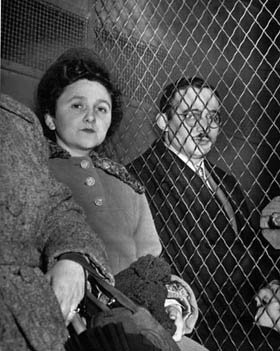Spies in America

Some notable American turncoats
by Gerry Brown and Beth Rowen |
 Ethel Rosenberg, 35, and her husband, Julius, 34, ride to separate jails in on New York City March 29, 1951 following their conviction as traitors in the nation's first atomic espionage trial. |
Countries have been spying on each other as long as there have been countries. Recently, the U.S. spy plane that crashed in China made headlines. When countries get their hands caught in the proverbial cookie jar, denial and feigned shock are the official reactions.
Here's a quick history of some other famous spies.
| Benedict Arnold |
Every schoolchild knows that Arnold is the textbook definition of a traitor. The bright and talented Revolutionary War brigadier general won several battles for the colonies including some naval clashes with the British on Lake Champlain before becoming a turncoat.
Still, he was passed over for promotion, and it wasn't until his victory at Fort Stanwix and his early command at the Battle of Saratoga that he received the proper rank of major general and the seniority that he felt he deserved.
Arnold was forced into corruption to make money in order to maintain his standard of living and received a light punishment following a court-martial. |
After he was wounded at the Battle of Saratoga Arnold, still quite bitter, Arnold was placed in command in Philadelphia where he lived above his means and worked himself into a pecuniary debt. About this time Arnold married Margaret Shippen, who was sympathetic to Britain.
Arnold was forced into corruption to make money in order to maintain his standard of living and received a light punishment following his court-martial. It was when Arnold discovered that he was to obtain the command of West Point that the British offered him 20,000 pounds to surrender West Point to them.
Before the plan was carried out, though, Major John Andre, the British go-between, was captured and hung while Arnold fled and became a brigadier general with British forces. Even his new loyalist friends were soured on him after he left Andre out to dry. He would lead raids on his old pals in Connecticut for the remainder of the war.
| Julius and Ethel Rosenberg |
The Rosenbergs became the first American civilains to be executed for spying when they were put to death at Sing Sing Prison in Ossining, New York.
Related Links | |
| Quiz: Counter Intelligence Encyclopedia: Espionage |
After Julius Rosenberg became an engineer with the U.S. Army Signal Corps in 1940, Ethel's brother, Sgt. David Greenglass, who worked on the atomic bomb project at Los Alamos, N.M., passed on nuclear weapon secrets to the Rosenbergs who then attempted to pass them on to the Soviet Union.
The middleman between the Rosenbergs and the Soviets, Harry Gold, was arrested in 1950 in connection with another spying case and he apparently sold out the Rosenbergs and Greenglass. Gold got 30 years while Greenglass, who ratted on the Rosenbergs and served as the government's chief witness in their prosecution, got off with a 15-year sentence.
The Rosenbergs, despite worldwide appeals for clemency, were not so lucky. They were convicted under the Espionage Act of 1917 and died in the electric chair on June 19, 1953.
| Aldrich Ames |
The CIA counterintelligence official, supposed to be uncovering Soviet spies himself, became a spy for the Soviet Union and sold out American operatives in the Soviet Union. Before he and his wife Rosario were arrested in 1994, as many as 12 double agents within the Soviet Union had been executed because of their betrayal.
Ames, whose father was a CIA analyst, entered the CIA as a trainee in 1962 while in college. In 1985, with the help of his wife, he began to sell secrets to the KGB and before they were caught had betrayed more than 100 operations and were paid nearly $3 million by the Soviet Union and Russia.
Ames, a 31-year CIA veteran, was sentenced to life in prison without parole after pleading guilty to charges of conspiracy to commit espionage as well as tax fraud. His wife received a lighter sentence.
